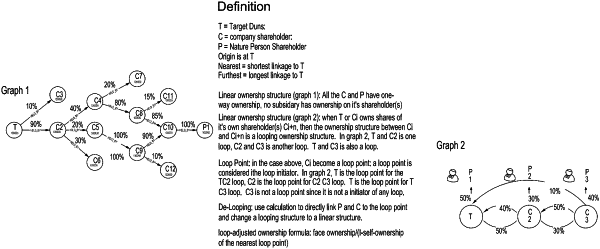| CPC G06F 16/9024 (2019.01) [G06F 16/245 (2019.01); G06F 16/248 (2019.01); G06Q 50/26 (2013.01); G06T 11/206 (2013.01)] | 28 Claims |

|
1. A method for determining the extent of beneficial ownership of a target business, comprising:
populating a database wherein businesses and ownership relationships between the businesses are represented by nodes and links;
querying the database to establish related ownership links;
analyzing the query to determine ownership loops;
de-looping the ownership relationships; and
calculating the percentage ownership of each of the beneficial owners of the target business based on de-looped ownership relationships;
wherein determining the extent of beneficial ownership of the target business further comprises:
a calculating direct ownerships for the target business;
b. assigning any missing ownership percentage to an unknown entity P so that the total direct ownership is one hundred percent;
c. for any entity that has direct ownership, calculating upper level indirect ownerships and assigning any missing, ownership to unknown entity P;
d. for any remaining entity that is still an indirect owner at an upper level, repeating step c until all ownerships are directed to at least one other entity Pi or unknown entity P;
e. identifying, all loop points and looping structures;
f. continuing to calculate the indirect ownership as in step c;
g. determining the furthest loop and loop point from the target business;
h. performing a self-ownership calculation by de-looping the furthest loop to calculate self-ownership of the furthest loop point;
i. using the self-ownership of each loop point to calculate a real/loop adjusted indirect ownership for each unknown entity P;
j. using the results from the de-looping to determine the self-ownership of a next furthest loop point from the target business;
k. repeating step j until self-ownership of all loop points is calculated;
l. aggregating direct and real/loop adjusted indirect ownership of each Pi to determine total ownership of the target business by each Pi as an ultimate beneficial owner; and
m. aggregating the direct and real/loop adjusted indirect ownership of the unknown entity P to determine unknown total ownership of the target business by the unknown entity P, as an unallocated ownership of the target business for which there is not enough data to determine one hundred percent ownership.
|